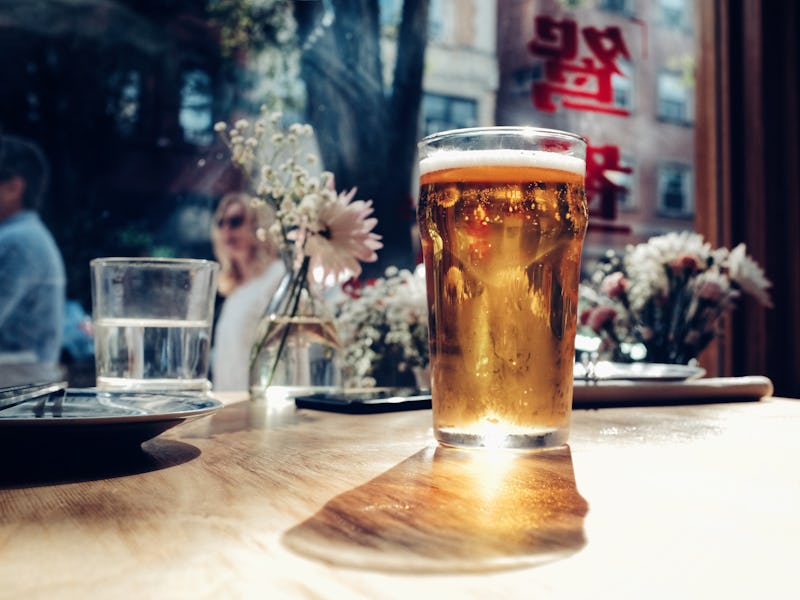The Biochemistry of Beer: Why the Source of Sugar Matters
Biochemistry is getting you buzzed.

Our eventual unraveling of the magic of alcohol was delayed by the fact that biology and chemistry look at the world in quite different ways. It was only by looking at both that people were finally able to explain the process of fermentation, by which yeast ingests sugar and excretes alcohol and carbon dioxide.
This is one of the simplest and oldest biochemical processes on the planet. But before that transformation is possible, you need the sugar itself. Sugar is one of the most important substances in nature. The competition for it, the complex interplay of plants, animals and microscopic fungi, ultimately gives us alcohol. So to fully understand fermentation we have to start with the source of that sugar. The kind of plant it comes from is the basis of the distinction between beer and other drinks .
Plants absorb water and carbon dioxide, and with the helping hand of sunlight and a few enzymes convert these into oxygen and sugar, via the process of photosynthesis. This simple process is the source of all the sugar in the world. It’s how plants live, and it starts the food chain that keeps animals alive. Run the program for long enough, and the plants that don’t get eaten ultimately become the source of all our fossil fuels, too.
This means the demand for sugar in nature often exceeds supply. This may be hard to believe when you look at the ever-expanding waistlines of the developed world, but sugar in nature is a scarce resource and, historically, the most sugary foods are the hardest to obtain and the most difficult to make. The domestication and refining of sugar goes back thousands of years, but in the West we’ve only been adding refined sugar to everything since the eighteenth century.
Plants create sugar so they can grow, and, at certain stages, so they can make fruit or seeds to give birth to new plants that ensure the survival of the species. A new seed cannot photosynthesize and create its own energy until it has grown leaves or shoots, and, usually, roots to anchor it in place and draw other nutrients from the soil. So the parent packs up its seed with an abundant source of sugar to help the baby plant survive and grow until it’s big and strong enough to create its own sugar.
There’s an important difference in how grain and fruit do this. Sometimes, the fruit or kernel surrounding the plant embryo has a cleverly customized role. If you’re a tree, you don’t want your kids settling too close or else you’ll soon be competing for nutrients and sunlight. So, many fruits have evolved a symbiotic relationship with animals. They attract wandering beasts or insects with sugary, aromatic flavor compounds. Animals find the fruit nutritious to eat, then carry the indigestible seeds away from the tree and deposit them in a fertile pile of manure some distance away.
If this doesn’t happen quickly enough, microorganisms will swoop in, and, when the fruit starts to rot, they’ll claim the sugar for themselves. Yeast is everywhere, especially in hot summers when fruit is ripening, and it’s always ready to claim vulnerable parcels of fermentable sugars. When it digests sugar it creates carbon dioxide and alcohol as by-products, a process which we refer to as fermentation. This is a wonderful result for humans and other higher order mammals, but not so great for the seeds that are left on the floor to die without their food parcels.
Grain is, in some ways, much cleverer than fruit, and has built sophisticated defenses against yeast. Because it’s smaller and lighter, it can be blown by the wind and doesn’t need as much distance from the parent plant, so it doesn’t have to put itself on show the same way apples or cherries do. And that means it can be smarter about how it packages the sugar for its offspring. Grains such as barley are like armour-plated, souped-up alternatives to fruit. A grain kernel, when it is ready to leave the plant, has a skin so hard no microbe or insect can get through it — even humans have to employ stone or metal mills if we want to crush the outer shell of a grain efficiently. And even if we succeed in doing that, the fuel within has further levels of protection: it’s stored not as simple sugar, but as long-chain starch molecules that are too big for microorganisms to attack. If a sugar molecule is a brick, starch is a wall. When the unstoppable force of yeast meets the immovable object of mature barley grains, nothing happens.
And so, some of the simplest and some of the most complicated organisms on Earth form an unholy alliance to separate the barley embryo for its sugary stash. Humans harvest and modify the grains to allow yeast to attack the sugars, and in return the yeasts create the alcohol humans love. Of course, the yeast can’t even know of or comprehend the existence or role of its human partners in crime. And for most of the time we’ve been doing this we’ve had no idea we were collaborating with yeasts either. We were in an alliance in which neither party knew the other existed. While on the human side we sort of knew what we were doing, we had no idea how, or why, it worked. We’ve been converting barley by “malting” it before brewing for thousands of years. We’ve known why we’re doing so for less than two hundred.
The above excerpt is from Pete Brown’s book Miracle Brew: Hops, Barley, Water, Yeast and the Nature of Beer (Chelsea Green Publishing, October 2017) and is reprinted with permission from the publisher.